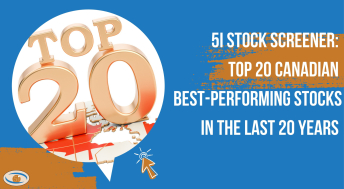If you are a bear, you should stop reading this now. It will only, um, make you grumpier. You are about to lose even more money betting against the market.
Someone needs to give investors a green light, indicating it is OK to go back into the equity market.
Let’s try and do that:
I checked with TD Waterhouse recently. Last month, on a $1 million dollar deposit, an investor would earn 0.15%. Doing the math, that works out to be $1500 per year. You have miraculously somehow saved up a million dollars—cash—and all your hard work and savings earns you a blistering $4.11 per day in interest.
Picking some random stock, on the other hand—say, Chesswood Group Ltd. (CHW on TSX) pays an 8.3% yield right now. Back to the math, that’s 55 TIMES what you would have earned in interest. On a daily basis, your $1 million now earns $226.84.
It takes your stock less than a week to beat a year’s worth of interest at today’s ridiculously low interest rates.
So, you make more than fifty times as much on your money, and you also get (a) the potential for capital gains; (b) the potential for higher dividends, and (c) a dividend tax credit.
Your interest payment, though, is ‘safe’. Unless of course there is massive inflation that destroys your buying power—we’ll save that for another blog.
“But what about Europe, Iran, high gas prices and economic uncertainty?” we hear the bears grumble. Let’s see how that is working out for you: Well, according to S&P, the actual total corporate earnings in 2012 are expected to hit new highs. Earnings in the third-quarter of 2011 were the highest ever. So, all the doom and gloom and fear in the economy has resulted in record corporate earnings. What, pray tell, could stocks do if the economy actually improved?
Oh, but wait, there’s more! The economy actually is, now, getting better. Job growth has resumed, the housing market has bottomed, retail sales are improving, and the financial system and the corporate world is awash in cash. Corporations can borrow money at exceptionally low rates, and plough that money back into growth, buying other companies or paying more in dividends.
Apple Inc. is a great recent example. Despite a $10 billion share buyback and a dividend initiated, in a matter of months it is still going to have more cash than it has now, even after spending $20 billion.
“But what about valuations?” the grizzlies grumble. “They are too high considering the economy”. Let’s take a look: The S&P 500 now trades at 13 times estimated price earnings (to 4Q 2012). The average PE over the past 25 years is 18.8 times. Sure, that includes the dotcom bubble, but it also includes a few crashes, so the average is probably a fairly accurate representation. At a 16 times PE ratio, the S&P 500 would be 19% higher than it is now; at the historical average, it would be 29% higher.
That looks pretty good, but let’s bring up the math again: Those PE ratios are averages. By definition, that means that, on average, the PE ratio has also been way higher than 18 times earnings, for part of the time. Suppose the PE rose to 21 times, the S&P 500 would then rise 57% from today’s levels.
“Oh, that would never happen”, say the bears. Yes, except, mathematically, it always does.
Finally, the last argument the bears typically use is that today’s financial situation is an artificial scenario, created by governments pumping liquidity into the system. To that, we say, “Who cares”. If you are playing a game of poker against an opponent with unlimited money (the FED), an unlimited time frame (the government) and the ability to change the rules at anytime (the FED and the government), why in the world would you even TRY and bet against that?
The bond market figured things out this week, with the biggest drop in six years. Guess where all that money is going to go?





Comments
Login to post a comment.